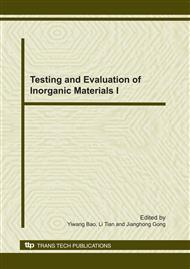p.41
p.45
p.49
p.54
p.58
p.62
p.66
p.70
p.74
Nanostructure of a Glass-Like Carbon Characterized by X-Ray Diffraction and Electron Energy Loss Spectroscopy
Abstract:
In our present study, phenolic resins heated at different temperatures from 600 oC to 3000 oC were analysised in terms of phase structure and chemical structure using X-ray diffraction and high resolution transmission electron microscopy equipped with an electron energy loss spectrometer (EELS). It is shown that materials appear to be amorphous with many micro-pores surrounded by crystalline graphite layers; the formation of the pore is due to the gas evolution reaction. Using the intensities of peaks in EELS CK-ionization edge which arise from transition of an atomic 1s electron to the π* and σ* antibonding band-like states, the percentage of sp2-bonded carbon have been analyzed and the results reveal notable differences with heat treatment temperature.
Info:
Periodical:
Pages:
58-61
Citation:
Online since:
December 2010
Authors:
Price:
Сopyright:
© 2011 Trans Tech Publications Ltd. All Rights Reserved
Share:
Citation:


